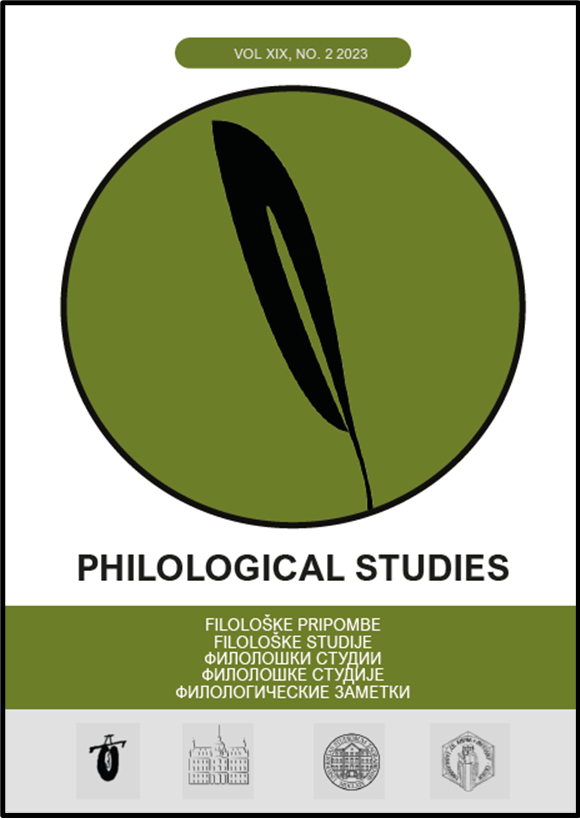ODNOS MED GLAGOLSKIMI KATEGORIJAMI IN ČASOVNO INTERPRETACIJO RUSKEGA DELEŽJA IN ŠPANSKEGA NEPERIFRASTIČNEGA GERUNDIJA
Апстракт
Prispevek predstavlja sopostavitveno analizo oblikoslovnoskladenjskih in pomenskih lastnosti ruskega deležja in španskega neperifrastičnega gerundija. Kot izhodišče smo vzeli konverb, ki je neosebna glagolska oblika, katere glavna funkcija je izražanje prislovnodoločilnega podredja. Na podlagi omenjene opredelitve skušamo najprej ugotoviti, ali lahko rusko deležje in španski neperifrastični gerundij prištevamo k omenjenemu slovničnemu pojavu. V nadaljevanju se osredotočimo na kategorijo glagolskega časa, ki ga razdelimo na absolutni in relativni čas, in ugotavljamo, kako rusko deležje in španski gerundij izražata časovne odnose. Posebna pozornost je namenjena opisu razlik v izražanju glagolskega vida v ruščini oziroma aspekta v španščini in raziskovanju, kako dana glagolska kategorija vpliva na pomensko interpretacijo deležja in gerundija. Na podlagi reprezentativnih primerov, vzetih iz rusko-španskega vzporednega korpusa, nazadnje analiziramo primarne prislovnodoločilne pomene ruskih deležij in španskih gerundijev, tj. časovne pomene istodobnosti, preddobnosti in zadobnosti. Na podlagi analize ugotavljamo, da rusko deležje in španski neperifrastični gerundij v vlogi konverba zaradi svojih aspektualnih lastnosti nista popolnoma prekrivna, zaradi česar se pri izražanju časovnih odnosov ne ujemata vedno.
Downloads
Референци
Bosque, Ignacio, Demonte, Violeta (Coord). (1999). Gramática de la lengua castellana (GDLE). Volumen 2. Madrid: Espasa Calpe. (In Spanish.)
Comrie, Bernard. (1976). Aspect. Cambridge: Cambridge University Press.
Comrie, Bernard. (1985). Tense. Cambridge: Cambridge University Press.
Fernández Lagunilla, Marina. (1999). Las construcciones de gerundio. In Bosque, Ignacio, Demonte, Violeta (Coord.): Gramática de la lengua castellana (GDLE). Volumen 2. Madrid: Espasa Calpe. (In Spanish.)
Haspelmath, Martin. (1995). The converb as a cross-linguistically valid category. In Haspelmath, Martin, König, Ekkehard (Ed.) Converbs in cross-linguistic perspective. Berlin: Mouton de Gruyter. 1–55.
Haspelmath, Martin, König, Ekkehard (Ed.). (1995). Converbs in cross-linguistic perspective. Berlin: Mouton de Gruyter.
Krvina, Domen. (2018). Glagolski vid v sodobni slovenščini 1: besedotvorje in pomen. [Verbal Aspect in Contemporary Slovenian: Word formation and Meaning]. Ljubljana: Založba ZRC. (In Slovenian.)
Markič, Jasmina. (1997). Aspektualne vrednosti v sodobni ameriški španščini v delih kolumbijskega pisatelja Gabriela Garcíe Márqueza (doktorska disertacija). [Aspectual values in modern American Spanish in the works of the Colombian writer Gabriel García Márquez (Doctoral thesis)]. Ljubljana: Filozofska fakulteta univerze v Ljubljani. (In Slovenian.)
Miguel, Elena de. (1999). El aspecto léxico. In Bosque, Ignacio, Demonte, Violeta (Coord.): Gramática de la lengua castellana (GDLE). Volumen 2. Madrid: Espasa Calpe. (In Spanish.)
Mora García, Javier. (2018). Historia y significados de las expresiones con gerundio y con en + gerundio. Epos: Revisa de filología, 1. 159–190. (In Spanish.)
Moreno, Arlanda. (2014). El gerundio no perifrástico. Estudio de corpus orales del Español de Mérida, Venezuela (Doctoral Thesis). Tromsø: Norges Arktiske Universitet, HSL. (In Spanish.)
Nedjalkov, Vladimir P. (1995). Some typological parameters of converbs. In Haspelmath, Martin, König, Ekkehard (Ed.) Converbs in cross-linguistic perspective. Berlin: Mouton de Gruyter. 97–136.
Real Academia Española y Asociación de Academias de la Lengua Española. (2009). Nueva gramática de la lengua española (NGLE). Madrid: Espasa Libros. (In Spanish.)
Sever, Jože, Derganc, Aleksandra. (2006). Ruska slovnica po naše. [Russian Grammar for Slovenians]. Ljubljana: Cankarjeva založba. (In Slovenian.)
Акимова, Т. Г., Козинцева, Н. А. (1987). Зависимый таксис (на материале деепричастных конструкций). В: Бондарко, Александр В (ред.): Теория функциональной грамматики: Введение. Аспектуальность. Временная локализованность. Таксис. Ленинград: Наука. 257–280. [Akimova, T. G., Kozinceva, N. A. (1987). Dependent taxis (based on the material of converb constructions). In: Bondarko, Aleksandr V. (Ed.): Theory of functional grammar: Introduction. Aspectuality. Temporary localization. Taxis. Leningrad: Nauka. 257–280.] (In Russian.)
Бондарко, Александр В. (ред.). (1987). Теория функциональной грамматики: Введение. Аспектуальность. Временная локализованность. Таксис. Ленинград: Наука. [Bondarko, Aleksandr V. (Ed.). (1987). Theory of functional grammar: Introduction. Aspectuality. Temporary localization. Taxis. Leningrad: Nauka.] (In Russian.)
Бондарко, Александр В. (1987). Общая характеристика семантики и структуры поля таксиса. В Бондарко, Александр В (ред.): Теория функциональной грамматики: Введение. Аспектуальность. Временная локализованность. Таксис. Ленинград: Наука. 234–243. [Bondarko, Aleksandr V. (1987). General characteristics of the semantics and structure of the taxis field. In Bondarko, Aleksandr V. (Ed.): Theory of functional grammar: Introduction. Aspectuality. Temporary localization. Taxis. Leningrad: Nauka. 234–243.] (In Russian.)
Виноградов, Виктор В. (1960). Грамматика русского языка. Том 1. Фонетика и морфология. Москва: Издательство Академии наук СССР. [Vinogradov, Viktor V. (1960). Russian Grammar. Volume 1. Phonetics and morphology. Moskva: Izdatel'stvo Akademii nauk SSSR.] (In Russian.)
Виноградов, Виктор В. (1947). Русский язык. Грамматическое учение о слове. Москва: Государственное учебно-педагогическое издательство Министерства просвещение РСФСР. [Vinogradov, Viktor V. (1947). Russian language. Grammatical teaching about the word. Moscow: Gosudarstvennoe učebno-pedagogičeskoe izdatel'stvo Ministerstva prosveščenija RSFSR.] (In Russian.)
Исаченко, Александр В. (1960). Грамматический строй русского языка в сопоставлении со словацким. Морфология. Часть вторая. Братислава: Издательство Словацкой академии наук. [Isačenko, Aleksandr V. (1960). The grammatical system of Russian language in comparison with Slovak. Morphology. Volume two. Bratislava: Izdatel'stvo Slovackoj akademii nauk] (In Russian.)
Князев, Юрий П. (2020). Деепричастие. В Молдован, Александр М. (ред.): Русский язык: Энциклопедия. Москва: АСТ-пресс. 136–139. [Knjazev, Jurij P. (2020). Gerund. V Moldovan, Aleksandr M. (Ed.): Russian language: Encyclopedia. Moscow: AST-press. 136–139.] (In Russian.)
Национальный корпус русского языка (НКРЯ). 2004–2021. [The Russian National Corpus (RNC).] https://ruscorpora.ru/new/search-main.html. (In Russian.)
Полянский, С. М. (1987). Одновременность/разновременность и другие типы таксисных отношений. В Бондарко, Александр В (ред.): Теория функциональной грамматики: Введение. Аспектуальность. Временная локализованность. Таксис. Ленинград: Наука. 243–253. [Poljanskij, S. M. (1987). Simultaneity/Non-Simultaneity and other types of taxis relations. In Bondarko, Alexander V (ed.): Theory of Functional Grammar: Introduction. Aspectuality. Temporary localization. Taxis. Leningrad: Nauka. 243–253.] (In Russian.)
Храковский, Виктор С. (ред.). (2009). Таксис: семантика, синтаксис, типология. Типология таксисных конструкций. Москва: Знак. [Khrakovsky, Viktor S. (Еd.). (2009). Taxis: semantics, syntax, typology. Typology of taxis constructions. Moscow: Znak] (In Russian.)
Шведова, Наталия Ю. (ред.). (1980). Русская грамматика. Том 1. Фонетика. Фонология. Ударение. Интонация. Словообразование. Морфология. Москва: Наука. [Švedova, Natalia Yu. (Ed.). (1980). Russian Grammar. Volume 1. Phonetics. Phonology. Accent. Intonation. Word formation. Morphology. Moscow: Nauka.] (In Russian.)
Авторски права (c) 2022 Vanesa Zaman

Ова дело е лиценцирано под меѓународната лиценца Creative Commons Attribution-NonCommercial-NoDerivatives 4.0.
Авторите во списанието претставуваат оригинални дела врз основа на резултатите од сопственото истражување. Лицата кои дале значителен придонес во трудот се наведуваат како коавтори. Заедно со статијата, авторите (и коавторите, доколку ги има) треба да достават пополнет образец за пријава на трудот (Paper Submission Form), со кој се потврдува согласноста на авторот за објавување на трудот.
Списанието прифаќа научни трудови кои претходно не биле објавени. Не се прифаќаат трудови кои во голема мера ги повторуваат претходно објавените трудови на авторите. Повторувањето подразбира и компилација – текст составен од фрагменти од објавена монографија или голем број на претходно објавени статии. Плагијатот не е дозволен, како и прекумерното цитирање на туѓи трудови (една третина или повеќе од целиот труд). Сите цитати, цитирани извадоци и материјали мора да имаат цитирани автори и извори. Ако уделот на туѓиот труд е преголем, се препорачува да се скратат цитатите и да се зголеми обемот на оригиналниот текст.
Авторот треба да ги има сите потребни дозволи за користење на позајмените материјали и материјалите на други автори што ги користи во својот труд (илустрации и слично). Авторот гарантира дека статијата не содржи информации што не подлежат на објавување во отворен печат, вклучувајќи ги и оние што содржат или претставуваат доверливи информации.
Во списокот на литературата се вклучени само делата цитирани во трудот, како и линковите за страниците и изворите од кои е цитирано доколку станува збор за извори од интернет. На авторот му се препорачува да ги наведе во текстот изворите на финансиска поддршка на спроведените истражувања и стипендиите, доколку ги имало. Исто така, може да се изрази благодарност и до колегите кои придонеле или помогнале околу работата на текстот, а кои не се коавтори.
Со доставувањето на ракописот и образецот на апликација до редакцијата, авторот официјално се согласува со објавувањето на неговиот труд во „Филолошки студии“. Авторите се носители на авторски права и ги задржуваат сите права за објавување и користење на статијата. Авторите имаат право да ја повлечат статијата во кое било време до моментот на објавување на сајтот, со тоа што претходно за тоа, по писмен пат, треба да ја известат редакцијата на списанието.
Статиите се објавуваат бесплатно. Содржината е достапна под лиценцијата Creative Commons Attribution-Noncommercial-No Derivative Works 3.0 Unported License.
Издавачка Етика
Редакција
Сите трудови доставени до Редакцијата ги читаат прво нејзините членови и соработници за да се утврди дали се однесуваат тие на релевантната проблематика и дали одговараат на форматот на списанието. Редакцијата на „Филолошки студии“ гарантира дека разгледувањето на доставените трудови и нивните рецензии не зависат од: комерцијални интереси, пол, националност, верски убедувања, политички ставови и други фактори. Единствениот критериум при изборот е академското ниво на трудот.
Во зависност од рецензијата, статијата може веднаш да се прати за објавување, да биде отфрлена или испратена до авторот за измена и за доработка. Во случај на несогласување со забелешките на рецензентот, авторот има право да ги оправда своите ставови. Доколку од рецензентите се добиени контрадикторни мислења, текстот се упатува на трет рецензент или конечната одлука се заснова на гласање на членовите на Редакцијата, по одделното разгледување.
Рецензенти
Статиите испратени до Редакцијата минуваат процес на двојно анонимно рецензирање. Имињата на рецензентите не треба да му бидат познати на авторот на статијата и обратно. Рокот за рецензирање е три-четири седмици. Рецензентите можат да бидат членови на Редакцијата и автори на списанието што објавувале претходно во него. Онаму каде што е неопходно, за рецензенти се назначуваат специјалисти од други: организации, градови и земји.
Рецензентите треба да бидат специјалисти за предметно-тематската област на која се однесува статијата. Редакцијата треба да спречи каков било судир на интереси во врска со дадениот научен труд и со неговиот автор.
Рецензентот е должен да им обрне внимание на членовите на Редакцијата за секоја суштинска сличност или поистоветување меѓу ракописот што се рецензира и која било друга публикација што му е позната. Рецензентот, исто така, е должен да го држи во тајност трудот што му е доверен, да не го пренесува на трети лица ракописот што му е доверен нему за рецензија и пред објавувањето на публикацијата да не ги објавува информациите содржани во него.
Рецензентите треба да дадат објективна, непристрасна и аргументирана процена на трудот. Забелешките треба да бидат формулирани коректно, така што оценувањето на трудот се однесува само на текстот на статијата и на неговата содржина. Рецензијата треба да биде напишана добронамерно, а наведените забелешки имаат за цел да им помогнат на авторите да ги коригираат утврдените недостатоци и да ја подобрат статијата пред да биде објавена таа на веб-страницата на издавачот и пред да биде достапна за пошироката публика.









